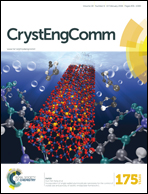Persistence of a self-complementary N–H⋯N tape motif in chloro-s-triazine crystals: crystal structures of simazine and atrazine herbicides and their polymorphic and inclusion behaviour†
Abstract
The bis-N-alkyl-chloro-s-triazines simazine 1 and atrazine 2 are potent and widely used commercial herbicides; however, their crystal structures have been unreported to date. This study reports the synchrotron crystal structures of 1 and 2, with the latter forming two polymorphs, as well as acting as a host structure for three haloalkane guest molecules. The molecular assembly in all of the crystal structures is an N–H⋯N hydrogen-bonded tape between hydrophobic phases formed by tightly packed alkyl side chains. The hydrogen-bonded tape is persistent across all structures in this study, and a survey of the literature and the Cambridge Structural Database (CSD) reveals the tape formation to be a persistent, highly stable motif in a range of chloro-s-triazines. The tape morphology occurs as different sub-groups that correlate to the volume of the N-substituent in a way that may permit a certain level of prediction and design for unknown crystal structures.


 Please wait while we load your content...
Please wait while we load your content...